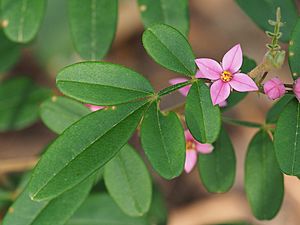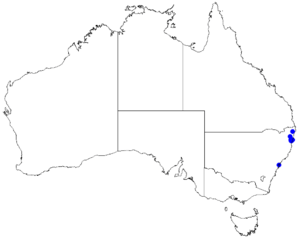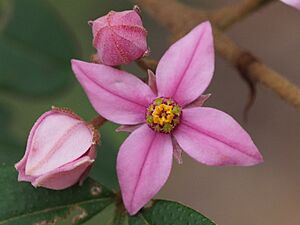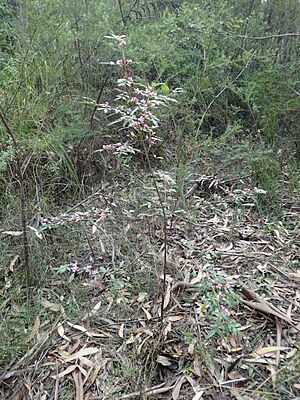Orara boronia facts for kids
Quick facts for kids Orara boronia |
|
|---|---|
 |
|
| Boronia umbellata in the Conglomerate Forest, near Nana Glen | |
| Conservation status | |
| Scientific classification | |
 |
|
| Occurrence data from Australasian Virtual Herbarium |
The Orara boronia (scientific name: Boronia umbellata) is a special plant that belongs to the citrus family, called Rutaceae. You can only find this plant in a small area on the north coast of New South Wales, Australia. It's an upright bush with many branches. Its leaves smell nice and are shaped like feathers (this is called pinnate). The plant grows groups of up to ten dark pink flowers where the leaves join the stem.
Contents
What Does the Orara Boronia Look Like?
The Orara boronia is an open bush that usually grows to about 1 metre (3 feet) tall. It has many branches covered in fine hairs.
Leaves of the Orara Boronia
The leaves of this plant are pinnate, which means they have smaller leaf parts called leaflets arranged along a central stem, like a feather. Each leaf can have three, five, or seven leaflets. The whole leaf is usually between 20 and 95 millimetres (0.8 to 3.7 inches) long and 10 to 55 millimetres (0.4 to 2.2 inches) wide. The stalk that holds the leaf, called a petiole, is about 6 to 20 millimetres (0.2 to 0.8 inches) long. The leaflet at the very end of the leaf is shaped like an oval. It is typically 21 to 43 millimetres (0.8 to 1.7 inches) long and 10 to 15 millimetres (0.4 to 0.6 inches) wide. The leaflets on the sides are similar but a bit shorter.
Flowers of the Orara Boronia
The flowers of the Orara boronia are a beautiful dark pink. They grow either by themselves or in groups of up to ten. Each flower sits on a small stalk called a pedicel, which is about 4 to 20 millimetres (0.2 to 0.8 inches) long.
Flower Parts
- The four sepals are small, triangular, and egg-shaped. They are about 2.5 to 3 millimetres (0.10 to 0.12 inches) long and 1.5 to 2 millimetres (0.06 to 0.08 inches) wide. They have hairs on their underside. Sepals are like small leaves that protect the flower bud.
- The four petals are the colourful parts of the flower. They are about 7 to 10 millimetres (0.28 to 0.39 inches) long and 3.5 to 5 millimetres (0.14 to 0.20 inches) wide. They have a few scattered hairs.
- The flower has eight stamens, which are the parts that produce pollen. They are different lengths, with those closer to the sepals being longer than those closer to the petals.
When Does it Flower and What About Fruit?
The Orara boronia usually flowers from June to November. After flowering, it produces a smooth, dry fruit called a capsule. This capsule opens up to release the seeds.
How the Orara Boronia Got its Name
The Orara boronia was first officially described in 1990 by a scientist named Peter H. Weston. He published his description in a scientific journal called Telopea.
Meaning of the Scientific Name
The second part of its scientific name, umbellata, is a Latin word. It means "like an umbrella." This name was chosen because the way the flowers are arranged can look a bit like an umbrella.
Where the Orara Boronia Lives
The Orara boronia grows in forests, especially near damp gullies. However, it is only found in a few specific places. These locations are between Lower Bucca and Glenreagh, which are both close to Coffs Harbour in New South Wales.
Protecting the Orara Boronia
Sadly, the Orara boronia is considered "vulnerable." This means it is at risk of becoming endangered or disappearing if we don't protect it. Both the Australian Government and the New South Wales Government have laws to help protect this plant.
Threats to the Plant
The main things that threaten the Orara boronia are:
- Habitat disturbance: This happens when its natural home is changed or damaged.
- Road works: Building or repairing roads can destroy the places where it grows.
- Timber harvesting: Cutting down trees for wood can also remove its habitat.
- Land clearing: When land is cleared for other uses, like farming or building, the boronia's home is destroyed.
Protecting these areas is very important to make sure the Orara boronia can survive and thrive for many years to come.




